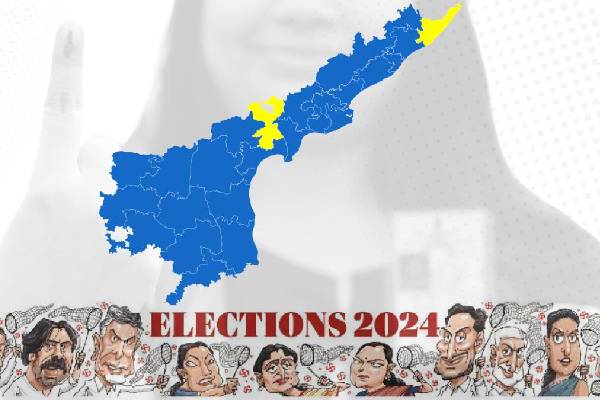The 2024 Andhra Pradesh (AP) assembly elections brought a dramatic shift in the political landscape of Andhra Pradesh. The National Democratic Alliance (NDA), comprising the Telugu Desam Party (TDP), Jana Sena Party (JSP), and Bhartiya Janata Party (BJP), won a staggering 164 out of 175 seats. In contrast, the YSR Congress Party (YSRCP) was confined to just 11 seats. Despite this, the vote percentage data reveals several critical insights.
2024 AP Assembly Election Statistics
- · Votes polled for Telugu Desam Party (TDP): 1,53,84,576 (45.60%)
- · Votes polled for Jana Sena Party (JSP): 23,17,747 (6.85%)
- · Votes polled for Bhartiya Janata Party (BJP): 9,53,977 (2.83%)
- · Total votes polled for NDA (TDP + JSP + BJP): 1,86,56,300 (55.28%)
- · Votes polled for YSR Congress Party (YSRCP): 1,32,84,134 (39.37%)
- · Total votes polled for the INDIA alliance (Congress, CPI, CPM): 6,36,454 (1.89%)
2024 AP Lok Sabha Election Statistics
- · Total votes polled for NDA: 1,77,74,004 (53.37%)
- · Total votes polled for YSRCP: 1,31,74,874 (39.61%)
- · Total votes polled for the INDIA alliance (Congress, CPI, CPM): 10,13,498 (3.05%)
2019 AP Assembly Election Statistics
- · Total votes polled for YSR Congress Party (YSRCP): 1,56,88,569 (49.95%)
- · Total votes polled for Telugu Desam Party (TDP): 1,23,04,668 (39.17%)
- · Total votes polled for Jana Sena Party (JSP) and allies (BSP, CPI, CPM): 19,60,892 (6.24%)
- · Total votes polled for Indian National Congress (INC): 3,68,810 (1.17%)
Key Takeaways
1. YSRCP’s Resilient Vote Share: Despite securing only 11 seats, YSRCP managed to garner 1,32,84,134 votes, translating to 39.37% of the vote share. This scenario is reminiscent of TDP’s 2019 performance where, despite winning only 23 seats, it secured 39.17% of the votes. This indicates a solid base for both parties, even in adverse conditions, demonstrating the resilience and dedicated support of their core voter base.
2. Risk of Complacency: While both TDP and YSRCP appear to have a consistent 39% vote share in challenging times, it would be imprudent to rely solely on this base. For example, in the 2023 Telangana assembly elections, the BRS secured 37.35% of votes but managed only 16.68% in the 2024 Lok Sabha elections. This example illustrates the danger of complacency, suggesting that neither TDP nor YSRCP can take their core support for granted.
3. The Pivotal Role of Jana Sena Party (JSP): Although JSP secured a smaller vote share compared to TDP and YSRCP, its influence is significant. With approximately 6.85% of the votes, JSP can potentially sway the outcome in future elections. This makes JSP a crucial player capable of either bolstering or undermining the larger parties.
4. Cross-Voting Dynamics: The INDIA alliance, led by the Congress party, received more votes in the Lok Sabha polls compared to the assembly polls, despite both elections being held simultaneously. This indicates a pattern of cross-voting. The common perception that minorities might vote for YSRCP in assembly elections and Congress in Lok Sabha elections is only partially true. However, since both TDP and YSRCP received fewer votes in the Lok Sabha compared to the assembly, it suggests that cross-voting occurred from supporters of both parties to the Congress.
5. Implications for Future Elections: The voting patterns suggest that while core voter bases remain strong, the margins are thin and susceptible to shifts. The alliance strategies, voter sentiment towards the central and state governments, and the performance of smaller parties like JSP will significantly influence the electoral outcomes.
6. Strategic Alliances and Campaigns: The data underscores the importance of strategic alliances and effective campaigning. NDA’s comprehensive victory in AP indicates successful coalition management and voter outreach, which were pivotal in consolidating votes across the state.
More Important Takeaway: Solid Vote Banks – A Danger for Democracy?
Both TDP and YSRCP have demonstrated solid vote banks, securing around 39% of the votes even in elections where they faced significant defeats that can be called disasters. Similarly, JSP’s 6% vote share, achieved despite contesting only 21 seats, suggests a potentially larger actual vote bank for JSP. This means that approximately 85% of voters in AP are strongly aligned with TDP, YSRCP, or JSP, leaving only 15% as neutral voters who make decisions based on performance rather than party loyalty. This trend can be detrimental to the democratic process as it leads to a rigid voter base, reducing the influence of policies and performance in electoral decisions. More voters making choices based on party performance and policies would enhance the quality of democracy. It is high time, the people of Andhra Pradesh realize this !!!
– ZURAN (@CriticZuran)
























